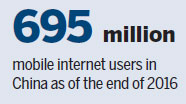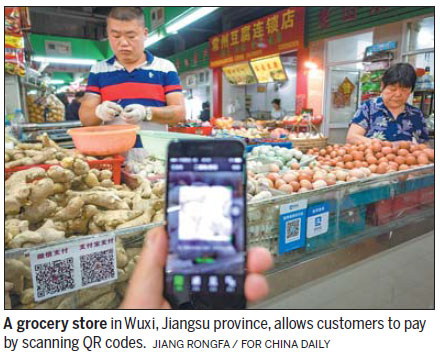Experts: China's 2-D barcodes need better security against rivals
Experts have suggested that China develop its own patent portfolio for two-dimensional barcodes, with a greater focus on core technology.
There are more than 10 versions of the two-dimensional barcode globally. The most commonly used one in China is the QR Code, invented by Japanese company Denso in 1994, said Shen Wei, deputy director of the 2-D Code Security Research Center at a forum held at Tsinghua University earlier this month.
The QR Code has become an international standard, widely used in many different fields.
The company is now working on a new series of patents, including five core technologies - facial, fingerprint, signet, holographic and signature recognition - which could play a significant role when combining two-dimensional barcodes with artificial intelligence, he said.
The new technology can be used in many fields, including media advertising, electronic identification, electronic signature, safe payment and the internet of things.
The applications for the five patents were filed in China in 2013 and are expected to be approved this year, Shen said.
"Denso's patents are ambitious, like a very fine fishing net, attempting to cover every aspect of the future development of barcodes, which may become a monopoly in the technical field," said Wang Yi, deputy director of the technology department of GS1 China, an affiliate of the General Administration of Quality Supervision, Inspection and Quarantine.

In the past 20 years, China has developed patents for two-dimensional barcode technologies.
Wuhan Syscan Technology began researching the encoding and decoding processes for barcodes in 2000. It gained a self-owned patent in 2003 and won the Chinese Patent golden award in December 2016.
The Grid Matrix code, developed by the company and featuring high fouling, buckling and deformation resistance, was applied into a big data cloud platform for traceability of food planting, production, processing, transportation and consumption to guarantee the safety of food.
The platform has entered 156 large supermarkets in Wuhan, Hubei province, as well as other regions such as Hebei and Jiangsu provinces.
The applications of Grid Matrix code also involve internet plus finance, tax, tourism and national security.
He Lihui from the China Registration & Certification of Two-Dimensional Code Center, said although China has many patents for barcodes, few of them dig into the core technology, and this lack of core patents could lead to economic and security risks.
The number of Chinese mobile internet users reached 695 million at the end of 2016, ranking No 1 in the world, statistics from the China Internet Network Information Center show.
Since the internet industry developed so quickly in China, the barcode-related intellectual property plays an important role in protecting internet safety, said Zhong Liduo, founder of GMedia Technology (Beijing) Co Ltd.
"We need to establish an effective authentication management system and technical tools to guarantee the security of information transmitted via the internet," Zhong said.
chenmeiling@chinadaily.com.cn

(China Daily 06/29/2017 page17)














